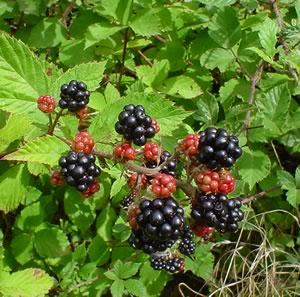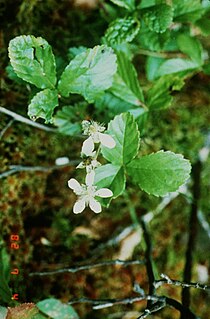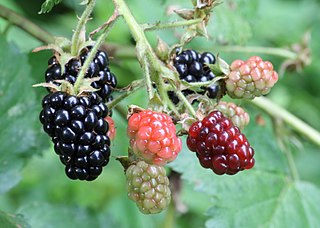
Rubus is a large and diverse genus of flowering plants in the rose family, Rosaceae, subfamily Rosoideae, with 250–700 species.

Rubus caesius is a Eurasian species of dewberry, known as the European dewberry. Like other dewberries, it is a species of flowering plant in the rose family, related to the blackberry. It is widely distributed across much of Europe and Asia from Ireland and Portugal as far east as Xinjiang Province in western China. It has also become sparingly naturalized in scattered locations in Argentina, Canada, and the United States.

Rubus hispidus, with the common names swamp dewberry, bristly dewberry, bristly groundberry, groundberry, hispid swamp blackberry or running swamp blackberry, is North American species of dewberry in the rose family.

Rubus ursinus is a North American species of blackberry or dewberry, known by the common names California blackberry, California dewberry, Douglas berry, Pacific blackberry, Pacific dewberry and trailing blackberry.

Rubus pubescens is a herbaceous perennial widespread across much of Canada and the northern United States, from Alaska to Newfoundland, south as far as Oregon, Colorado, and West Virginia.

Rubus flagellaris, the northern dewberry, also known as the common dewberry, is a North American species perennial subshrub species of dewberry, in the rose family.
Rubus whartoniae, also called Wharton's dewberry, is a rare North American species of flowering plant in the rose family. It has been found only in the states of Kentucky and Tennessee in the east-central United States.
Rubus aboriginum is a North American species of dewberry, known as the garden dewberry and aboriginal dewberry. Like other dewberries, it is a species of flowering plant in the rose family, related to the blackberry. It is native to the United States and Mexico, primarily in the southern Great Plains with additional populations scattered in the eastern United States and in Nuevo León.

Rubus invisus is a species of dewberry, known as upland dewberry. Like other dewberries, it is a species of flowering plant in the rose family, related to the blackberry. It is found in the eastern and east-central United States.
Rubus alter, the Maine dewberry, is a North American species of flowering plant in the rose family. It is native to the states of Maine and New Hampshire in the northeastern United States.
Rubus apogaeus, the falling dewberry, is an uncommon North American species of flowering plant in the rose family. It is found in scattered locations in the southern United States.
Rubus aptatus, the drybank dewberry, is a rare North American species of flowering plant in the rose family. It is found in scattered locations in the northeastern United States.
Rubus arizonensis, called Arizona dewberry, is an uncommon North American species of flowering plant in the rose family. It is found in northwestern Mexico (Sonora) in the southeastern United States.
Rubus clarus, the Mt. Vernon dewberry, is a rare North American species of flowering plant in the rose family. It has been found only in the state of Virginia in the east-central United States.
Rubus exsularis, the fenceline dewberry, is a rare North American species of flowering plant in the rose family. It has been found in the northeastern and north-central United States, primarily in the Appalachian Mountains from New York to Kentucky, with a few isolated populations in southeastern Wisconsin.
Rubus felix, the woodland dewberry, is a rare North American species of flowering plant in the rose family. It has been found in scattered locations in the eastern United States.
Rubus segnis is an uncommon North American species of flowering plant in the rose family. It grows in eastern Canada and the northeastern United States. Nowhere is it very common.
Rubus vigoratus is an uncommon North American species of flowering plant in the rose family. It grows in Nova Scotia and Massachusetts. Nowhere is it very common.
Rubus plicatifolius is a North American species of dewberry in the rose family. It is found in eastern and central Canada and in the eastern and central United States.








